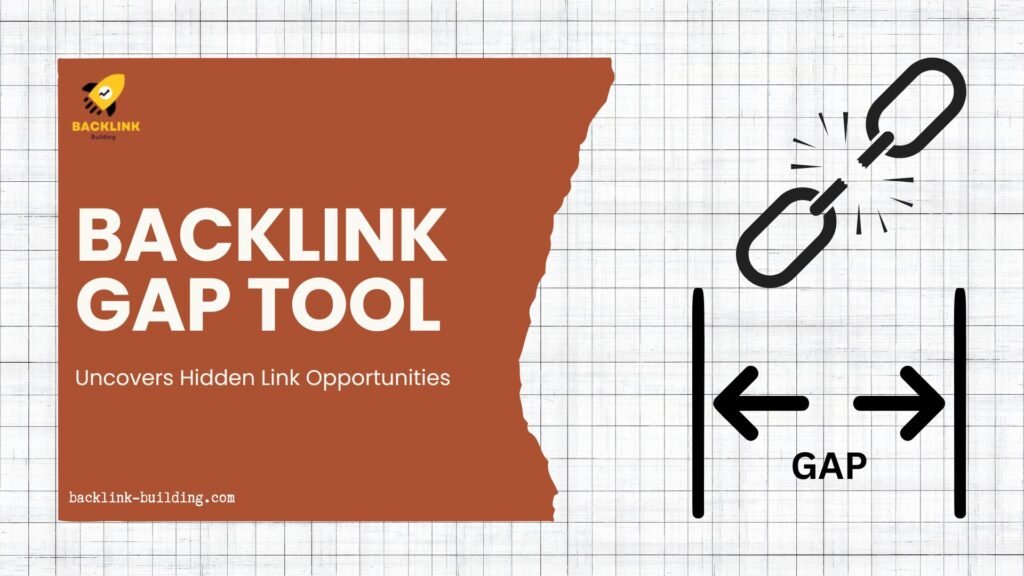
So, you are working hard to improve your website. You are writing great content, fixing the design, and doing everything right. But your competitors are still ahead of you in Google search results. Why?
One big reason could be backlinks.
Backlinks are links from other websites that point to your site. They tell Google that your website is trusted and useful. The more good backlinks you have, the higher your pages can rank.
But here is the thing.
Your competitors may have backlinks that you do not. These links are helping them rank better. And if you do not find and build similar links, it will be tough to catch up.
That is where a backlink gap tool can help.
Let us dive into how it works and why it can be a game-changer for your SEO.
What Is a Backlink Gap Tool?
A backlink gap tool is like a detective for your website.
It shows you which websites are linking to your competitors but not linking to you. In other words, it reveals the “gap” in your backlink profile.
Let us say your site is called “BestCoffeeTips.com,” and your top three competitors are:
- CoffeeLoversBlog.com
- BrewPerfect.com
- MorningCupGuru.com
If these sites have backlinks from “HealthyLiving.com,” “TopBlogs.net,” and “CafeLife.org” — but you do not — that is your backlink gap.
These are the link opportunities you are missing. And you can now go after them.
Why Backlink Gap Tool Matters
You might wonder, Why can I not just build random backlinks?
Well, not all backlinks are helpful. You need the right kind of backlinks. Ones that are:
- Relevant to your niche
- From trusted websites
- Already linking to your competitors
That last point is key.
If a site already links to your competitors, it is proof that they are open to linking to websites like yours. So, your chances of getting a backlink from them are higher.
A backlink gap tool helps you:
- Save time
- Avoid guessing
- Focus on what actually works
How Does a Backlink Gap Tool Work?
Using a backlink gap tool is pretty simple. Here is a basic idea of how it works:
- You enter your website URL
- You enter 2 to 5 of your top competitors
- The tool scans all the websites and compares backlinks
- It shows you which websites are linking to your competitors but not to you
That list is your goldmine.
Most tools also give extra info like:
- Domain rating or trust score
- Anchor text used
- How many competitors have the same link
- The page where the link is placed
This info helps you decide which links are worth chasing.
Signs You Need a Backlink Gap Tool
Still unsure if this tool is for you? Here are some signs:
1. Your Competitors Rank Higher Than You
If your competitors are showing up above you in Google search results—even when your content is great—it could be because they have stronger backlinks.
2. Your Organic Traffic Is Stuck or Dropping
You’re posting content, optimizing pages, and doing all the right things… but your traffic is not growing?
That’s a sign your off-page SEO (like backlinks) is weak compared to others in your niche.
3. You Have Fewer Referring Domains Than Others
If you check tools like Ahrefs or SEMrush and see that your site has way fewer referring domains than your top competitors, that’s a red flag.
4. You’re Not Sure Where to Start With Link Building
Link building can feel overwhelming. If you don’t know who to reach out to or what to pitch, a backlink gap tool can guide you.
5. You’re Building Links But Not Seeing Results
If you’re doing outreach but getting no traction, maybe you’re targeting the wrong sites.
6. You Just Launched a New Website or Page
New websites and content pages need backlinks to get noticed.
7. You Want to Outrank Specific Pages
If you’re targeting a keyword and want to outrank a specific blog post or competitor page.
If any of these sound familiar, then yes — you need a backlink gap tool.
How To Use a Backlink Gap Tool Step-by-Step
Here’s a step-by-step guide on how to use a backlink gap tool:
Step 1: Choose a Backlink Gap Tool
Some popular tools you can use:
- Ahrefs (Link Intersect Tool)
- SEMrush (Backlink Gap Tool)
- SE Ranking
- Moz Link Intersect
- Ubersuggest
Pick any one. Each of these tools works a little differently, but the main idea is the same. They help you spot backlink opportunities your site is missing.
Some tools are free for basic use. Others need a paid plan for full results. Choose what fits your needs and budget.
Step 2: Enter Your Website and Competitors’ URLs
- Open the tool.
- Add your website first.
- Then, add 2-4 competitor websites.
(These should be websites that rank higher than you for your target keywords.)
The tool will compare your site with the others.
Step 3: Click on “Find Opportunities” or “Compare”
After you’ve added the domains, click the button to run the analysis.
The tool will now scan and show:
- Websites that link to your competitors
- But do not link to you
These are your gap opportunities.
Step 4: Review the Results
You’ll see a list of websites with links to your competitors.
Things to look at:
- Which competitor has the link?
- Which page the link is on?
- Is the site high-quality?
- What kind of content was linked?
You can sort by:
- Domain Rating (DR)
- Referring domains
- Follow/nofollow links
Step 5: Create a List of Link Opportunities
Make a list of the websites that:
- Look relevant to your content
- Have good authority
- Are not spammy
Also, note which content of your competitors got the link. This will help you plan your outreach.
Step 6: Reach Out and Pitch Your Content
Now it’s time to ask for the backlink.
You can:
- Create a better version of the content that got the link
- Suggest your page as an additional helpful resource
- Offer to write a guest post for that site
- Fix a broken link (if the competitor’s link is dead)
Send a short and friendly email to the website owner. Focus on how your content helps their readers.
Step 7: Track and Repeat
- Keep track of which sites replied and linked to you.
- Update your backlink gap list every few weeks.
- Keep finding new competitors to compare with.
What To Do With the Results
Now that you have the list, what next?
Start reaching out to those websites and try to earn backlinks. Here are a few ways:
1. Guest Posts
Offer to write a helpful article for their blog.
2. Broken Link Outreach
Check if their site has broken links and suggest your link as a replacement.
3. Content Suggestions
If your site has a helpful guide or post, let them know and ask if they can link to it.
4. Partnerships
Look for ways to build a long-term connection. Maybe you can do a content exchange or feature each other.
Tips To Make Your Outreach Work
Backlink outreach can feel a little scary at first. But it does not have to be.
Here are some easy tips:
- Keep your emails short and friendly
- Show that you read their content
- Explain why your link helps their readers
- Follow up once if they do not reply
Do not spam. Be kind and respectful. Even if they say no, thank them and move on.
Mistakes To Avoid
Many people make these common mistakes:
- Reaching out to low-quality websites
- Sending the same message to everyone
- Asking for links without offering value
- Ignoring personalization
A backlink is like a vote of trust. Treat it that way.
Take time to build real relationships with other websites. That will bring better results.
What Makes a Backlink Valuable?
Not all backlinks are created equal. Here is what makes a backlink more valuable:
- The website is trusted and well-known
- The content is related to your niche
- The link is in the main content, not the footer
- The anchor text makes sense
- The page gets real visitors
Focus on quality over quantity. One great backlink can be better than ten weak ones.
Real-Life Example
Let us take a simple example.
Jane runs a website called “HealthySnackIdeas.com.” She is struggling to rank for “easy lunchbox ideas.”
She uses a backlink gap tool and finds out:
- Three of her competitors have links from “MomsBestTips.org”
- Her site does not
She visits MomsBestTips.org and sees they have a guest post section.
Jane reaches out, offers a helpful post about “10 Healthy Lunchbox Snacks for Kids,” and they say yes.
She writes the post, includes a link to her site, and it gets published.
A few weeks later, she sees a jump in traffic and rankings.
That is the power of using a backlink gap tool.
Final Thoughts
If you want to improve your SEO, do not ignore backlinks. And if you want to build the right backlinks, a backlink gap tool is your best friend.
It helps you:
- Discover what your site is missing
- Learn from your competitors
- Find link opportunities you can actually win
- Grow your traffic in a smart way
Do not just guess your way through link building. Use data. Use tools. Use the backlink gap strategy.
And remember, it is not about copying others. It is about learning what works and doing it better in your own way.
Happy link building!


